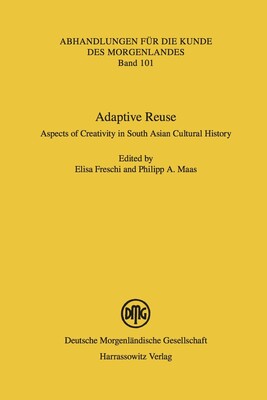Elisa Freschi, Philipp André Maas (eds.), 2017
Adaptive Reuse: Aspects of Creativity in South Asian Cultural History. Wiesbaden: Harrassowitz, 2017 (download [open access]).
“Adaptive reuse,” an influential theoretical concept in the field of architecture, describes the reuse of partly reconstructed buildings for purposes different from those for which they were originally erected. In the present volume, this concept is for the first time transferred from its edificial application to a wider specter of cultural activities, namely to the composition of texts and to the creation of concepts and rituals. The volume opens with an introduction in which the editors explain their understanding of of adaptive reuse and its innovative application to cultural studies. They differentiate between simple re-use and adaptive reuse as two ideal types of re(-)use. Simple re-use is the resumption of a previous use without a strong change of purpose. An item is simply used again, because it is readily available. Adaptive reuse implies more. The reuser aims at well-definable purposes, e.g., adding prestige, credibility or authority to the newly created work. The reused elements have therefore to be recognizable. Adaptive reuse ideally involves a strong change of usage, and it is not primarily motivated economically. The twelve main chapters of the volume are divided into four thematic sections. Section 1, “Adaptive Reuse of Indian Philosophy and Other Systems of Knowledge,” consists of five case studies by Philipp Maas, Himal Trikha, Ivan Andrijanic, Yasutaka Muroya and Malhar Kulkarni dealing with the adaptive reuse of Sanskrit philosophical and grammatical texts in Sanskrit works of philosophy, grammar and poetry. In all these cases, adaptive reuse serves the creation of new forms and contents within a traditionally established framework in which the prestige of the sources of adaptive reuse reflects upon its target. In the second section, entitled “Adaptive Reuse of Tropes,” Elena Mucciarelli and Cristina Bignami analyze the motif of the chariot in Vedic, medieval and contemporary works and rituals and fruitfully employ the concept of adaptive reuse in various religious contexts. The chapters of the third section “Adaptive Reuse of Untraced and Virtual Texts” by Daniele Cuneo, Kiyokazu Okita, Elisa Freschi and Cezary Galewicz deal again with philosophical and religious texts, this time focusing on the adaptive reuse of sources that are no longer available or did never exist. It emerges from these studies that reuse of virtual texts was frequently intended to support the introduction of innovations into established traditions. In some cases, the prestige of the reusing works even reflected back on the allegedly reused source. Finally, the chapter by Sven Sellmer in the fourth section “Reuse from the Perspective of the Digital Humanities” deals with the computer-based identification of possibly reused text-passages in epic literature that otherwise would remain undetectable.
